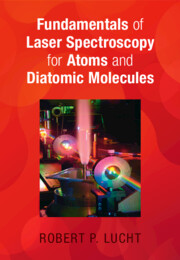Book contents
- Frontmatter
- Dedication
- Contents
- Preface
- 1 Introduction
- 2 Atomic Structure and the Quantum Mechanics of Angular Momentum
- 3 Structure of Diatomic Molecules
- 4 Quantum Mechanical Analysis of the Interaction of Laser Radiation with Electric Dipole Resonances
- 5 Quantum Mechanical Analysis of Single-Photon Electric Dipole Resonances for Diatomic Molecules
- 6 Absorption and Emission Spectroscopy
- 7 Raman Spectroscopy
- 8 Coherent Anti-Stokes Raman Scattering (CARS) Spectroscopy
- Spherical Harmonics and Radial Wavefunctions for One-Electron Atoms
- Clebsch–Gordan Coefficients, Dipole Moments, and Spontaneous Emission Coefficients for the 2p–1s Transition in Atomic Hydrogen
- Properties and Values for Selected 3j Symbols
- Properties and Values for Selected 6j Symbols (Weissbluth, 1978)
- Allowed LS Coupling Terms for Equivalent d2 Electrons
- Derivation of the Higher-Order Density Matrix Elements for Doublet and Triplet Electronic Levels
- Einstein Coefficients for Spontaneous Emission for the X2Π–A2Σ+ (0,0) Bands of OH and NO and the X3Σ−–A3Π (0,0) Band of NH
- Effect of Hyperfine Splitting on Radiative Transition Rates
- Voigt Function Values
- References
- Index
5 - Quantum Mechanical Analysis of Single-Photon Electric Dipole Resonances for Diatomic Molecules
Published online by Cambridge University Press: 12 December 2024
- Frontmatter
- Dedication
- Contents
- Preface
- 1 Introduction
- 2 Atomic Structure and the Quantum Mechanics of Angular Momentum
- 3 Structure of Diatomic Molecules
- 4 Quantum Mechanical Analysis of the Interaction of Laser Radiation with Electric Dipole Resonances
- 5 Quantum Mechanical Analysis of Single-Photon Electric Dipole Resonances for Diatomic Molecules
- 6 Absorption and Emission Spectroscopy
- 7 Raman Spectroscopy
- 8 Coherent Anti-Stokes Raman Scattering (CARS) Spectroscopy
- Spherical Harmonics and Radial Wavefunctions for One-Electron Atoms
- Clebsch–Gordan Coefficients, Dipole Moments, and Spontaneous Emission Coefficients for the 2p–1s Transition in Atomic Hydrogen
- Properties and Values for Selected 3j Symbols
- Properties and Values for Selected 6j Symbols (Weissbluth, 1978)
- Allowed LS Coupling Terms for Equivalent d2 Electrons
- Derivation of the Higher-Order Density Matrix Elements for Doublet and Triplet Electronic Levels
- Einstein Coefficients for Spontaneous Emission for the X2Π–A2Σ+ (0,0) Bands of OH and NO and the X3Σ−–A3Π (0,0) Band of NH
- Effect of Hyperfine Splitting on Radiative Transition Rates
- Voigt Function Values
- References
- Index
Summary
The interaction of electromagnetic radiation with single-photon resonances in diatomic molecules is discussed in this chapter. The properties of the electric dipole moment of the molecule are determined primarily by the electron cloud that binds the two nuclei together, and these properties can be understood by considering a reference frame fixed to the molecule. However, the response of the molecule must be averaged over all possible orientations of the molecule in the laboratory frame. Using irreducible spherical tensors greatly simplifies the orientation averaging of the molecular response. The Born–Oppenheimer approximation is invoked to initially account for the effect of the electronic, vibrational, and rotational modes of the molecule. Corrections are applied to account for the coupling and interactions of the different modes, including Herman–Wallis effects. Tables of rotational line strengths are presented for singlet, doublet, and triplet electronic transitions. These tables incorporate the use of Hund’s case (a) basis state wavefunctions for increased insight into radiative interactions for levels intermediate between Hund’s cases (a) and (b).
Keywords
- Type
- Chapter
- Information
- Publisher: Cambridge University PressPrint publication year: 2024

